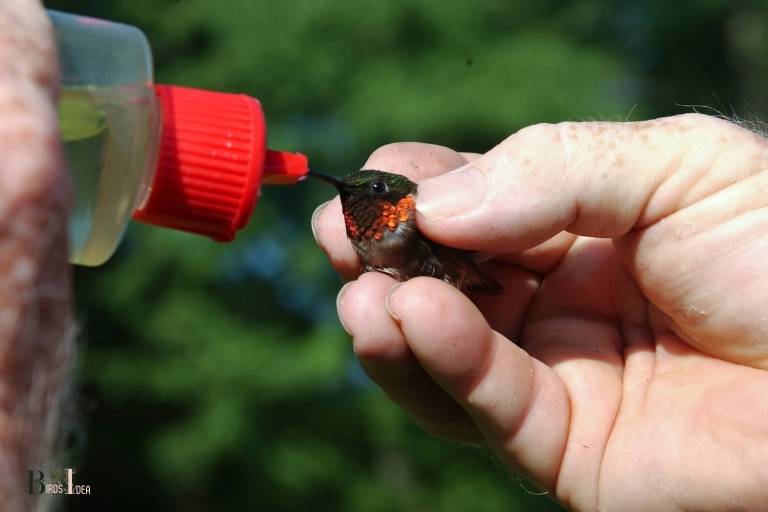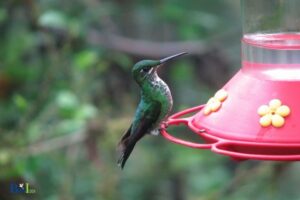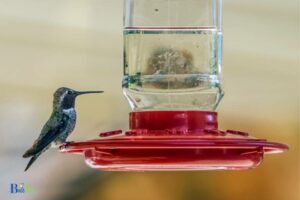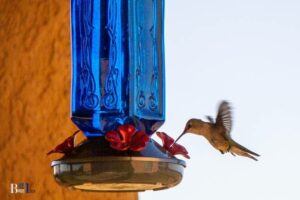How To Feed Hummingbirds By Hand?
Hand feed hummingbirds using a small handheld feeder or nectar in a small container.
Feeding hummingbirds by hand creates a special connection with these tiny birds while providing them with essential energy from nectar.
To hand feed hummingbirds, fill a handheld feeder or shallow container with homemade nectar and hold it near existing hummingbird feeders or flowers they frequent.
Stand or sit quietly and patiently, keeping the feeder steady.
Over time, the hummingbirds will become used to your presence and start feeding from your hand.
Remember not to wear any strong-smelling perfumes or lotions and keep a safe distance from their nesting sites to ensure a pleasant experience for both you and the birds.

8 Steps To Feed Hummingbirds By Hand
| Step | Description |
|---|---|
| 1 | Prepare the sugar solution: Mix 1 part sugar with 4 parts water in a container. Heat the mixture until the sugar dissolves completely, then let it cool down. |
| 2 | Fill a small vial or bottle cap with the sugar solution. |
| 3 | Choose a spot near a hummingbird feeder or an area where hummingbirds frequent. |
| 4 | Put on a brightly colored shirt (preferably red) to attract hummingbirds. |
| 5 | Stand or sit very still near the chosen spot, holding the vial or bottle cap with the sugar solution in your hand. It’s best to have your arm resting on something to keep it steady. |
| 6 | Wait patiently for a hummingbird to approach. They may be hesitant at first, but with time they will get closer. |
| 7 | Remain still and observe as the hummingbird feeds from the sugar solution in your hand. Do not make sudden movements or try to touch the bird, as this can scare it away. |
| 8 | Refill the vial or bottle cap as needed and continue to enjoy the experience of feeding hummingbirds by hand. |
What Do Hummingbirds Eat and How to Attract Them?
Hummingbirds primarily consume nectar, insects, and spiders, which provide them with essential nutrients and energy to maintain their rapid metabolism.
To attract these fascinating birds and even feed them by hand, you can set up an environment that caters to their dietary needs and preferences.
- Provide a hummingbird feeder filled with a homemade nectar solution (4 parts water to 1 part sugar) or buy ready-made nectar from a store.
- Offer native flowering plants that produce nectar such as salvia, honeysuckle, and trumpet vine.
- Ensure a clean and safe environment by regularly cleaning feeders and offering a fresh supply of nectar.
- Place the feeder near flowers or shrubs where hummingbirds can perch and rest between feedings.
- Offer a water source, such as a shallow dish or a fountain with moving water to help them stay clean and hydrated.
“Feeding hummingbirds by hand is a unique and unforgettable experience that connects us with nature and brings us closer to these amazing creatures.”
birdsidea
How to Prepare Hummingbird Food?
Feeding hummingbirds by hand is an exciting and rewarding experience, as it allows you to get up close and personal with these fascinating creatures.
Preparing hummingbird food is simple and involves creating a sugar-water solution that replicates the nectar found in flowers.
- Mix one part granulated white sugar with four parts boiling water. This ratio closely resembles natural nectar.
- Stir the mixture until the sugar is completely dissolved. Avoid using honey, red dye, or other additives, as these can be harmful to the birds.
- Allow the solution to cool to room temperature before using it to feed the hummingbirds.
- Store any excess hummingbird food in the refrigerator for up to a week. Replace the solution in your feeder every 2-3 days, especially during hot weather, to prevent spoilage and the growth of harmful bacteria.
Pro Tip: Hold a small container filled with the sugar-water solution in your hand while standing near the hummingbird feeder. Remain still and patient, and with time, the curious hummingbirds might overcome their initial wariness and feed right from your hand.
birdsidea
What to Keep in Mind When Feeding Hummingbirds by Hand?
Feeding hummingbirds by hand can be an incredibly rewarding and intimate experience with nature.
However, it’s essential to keep the hummingbirds’ safety and health in mind when conducting this activity.
Here are some crucial points to consider while feeding hummingbirds by hand:
- Sanitize your hands: Ensure your hands are clean and free of chemicals, perfumes, or insect repellents that may be harmful to hummingbirds.
- Use proper nectar: Prepare a homemade sugar solution (4 parts water and 1 part white granulated sugar) or buy a commercial hummingbird nectar product. Avoid using honey, red dye, or artificial sweeteners as they can be toxic to hummingbirds.
- Hold the feeder steadily: To avoid startling the birds, hold the feeder or nectar container securely with a steady hand.
- Stay patient and still: It may take some time for hummingbirds to trust you enough to approach. Keep still and minimize sudden movements that may scare them away.
- Observe from a distance: Keep a reasonable distance from the bird, and avoid reaching out or trying to grab them. Instead, enjoy observing their natural behavior.
- Respect their environment: Make sure to feed hummingbirds in their natural habitat and avoid disrupting the local ecosystem.
- Provide additional food sources: To not make the hummingbirds overly reliant on your hand-feeding, provide them with additional food sources like native plants and flowers.
Overall, when feeding hummingbirds by hand, remember to prioritize their safety and well-being, remain patient, and appreciate the beauty of these tiny creatures.
Pro Tip: When attempting to hand-feed hummingbirds, remain still and patient near the feeder. Once the birds become accustomed to your presence, try holding a small container of nectar or a red flower in your hand for them to feed from. Keep in mind that this may take some time and patience, but the experience can be incredibly rewarding and awe-inspiring.
birdsidea
Tips and Techniques for Feeding Hummingbirds by Hand
Feeding hummingbirds by hand can be a delightful and enriching experience for bird lovers. With patience and the right techniques, you can create a memorable bonding moment with these tiny, fascinating creatures.
Here are some essential tips and techniques to successfully hand-feed hummingbirds:
Choose the right feeder: Start with a small, easy-to-clean hummingbird feeder that can fit comfortably in your hand without causing strain or discomfort.
Prepare the nectar: Make your own hummingbird nectar by mixing one part granulated sugar with four parts water. Boil the mixture and let it cool before filling the feeder.
Select a suitable location: Find a quiet, shaded spot near flowers that hummingbirds frequent and where you can sit or stand comfortably for an extended period.
Wear muted colors: Hummingbirds can be skittish, so wear calm, earth-tone clothes to help them feel more comfortable approaching you.
Establish a routine: Visit your chosen spot at a consistent time each day for a week or two, giving the birds a chance to get used to your presence.
Replace an existing feeder: Once the hummingbirds are comfortable with your presence, temporarily remove a feeder they regularly visit and replace it with the handheld one.
Remain still and patient: Hold the feeder steady and maintain a quiet, still presence as hummingbirds approach.
Respect their space: Keep a respectful distance if a hummingbird seems hesitant and avoid sudden movements that might scare them away.
Maintain hygiene: Clean the feeder regularly to prevent mold and bacteria growth, which can be harmful to hummingbirds.
By following these tips and techniques, you can increase your chances of successfully hand-feeding hummingbirds and create a special connection with these enchanting creatures.
Remember, patience is key, and the experience will become more rewarding as the birds grow accustomed to your presence.
Benefits of Feeding Hummingbirds by Hand
Feeding hummingbirds by hand can be a truly rewarding experience, as it allows you to connect with these beautiful creatures on a personal level.
By offering them a safe and nourishing source of nectar, you can create a space where they can visit regularly and trust your presence.
Aside from being an enjoyable pastime, hand feeding hummingbirds has its benefits:
- Conservation support: Hand-feeding hummingbirds can contribute to their well-being and preservation by providing a reliable source of nutrients, especially during harsh seasons or when natural food sources are scarce.
- Encouraging pollination: Attracting hummingbirds to your garden can boost your plants’ health and productivity by promoting the pollination process.
- Educational opportunities: Hand feeding hummingbirds offer an excellent opportunity to learn about their behaviors, feeding patterns, and physical characteristics up close.
- Stress relief: Spending time with hummingbirds can provide you with emotional and mental benefits, as observing their fascinating behaviors and vibrant colors can be a calming and therapeutic experience.
- Photography and observation: Hand feeding hummingbirds creates unique opportunities to capture stunning photographs and closely observe these tiny yet mesmerizing creatures.
To successfully feed hummingbirds by hand, follow these steps:
- Prepare a nectar solution by mixing one part white sugar with four parts of water.
- Place a nectar feeder in your garden to attract hummingbirds and let them get used to the feeder’s presence.
- After a few days, approach the feeder slowly and calmly while holding a small container with the nectar solution.
- Once the hummingbirds become familiar with your presence, try holding the nectar container closer to your hand.
Remember to remain patient and still, as it might take some time for the hummingbirds to feel comfortable enough to feed from your hand.
Through this remarkable experience, you can gain a newfound appreciation and connection with these captivating birds.
Safety Precautions for Feeding Hummingbirds by Hand
Feeding hummingbirds by hand can be a rewarding and unique experience. However, to ensure the safety of both the birds and yourself, it is essential to follow some necessary precautions.
Here are some safety measures to keep in mind:
- Cleanliness: Maintain clean hands and feeding equipment to prevent transmitting diseases to the birds.
- Patience: Hummingbirds may take some time to approach, so be patient and avoid making sudden movements that may startle them.
- Utilize a Feeder: Use a small handheld feeder or a bottle cap filled with nectar to make it easy for the hummingbirds to feed.
- Appropriate Nectar: Use a sugar-water mixture (4 parts water to 1 part sugar) to mimic natural nectar, and avoid using honey or artificial sweeteners, which can be harmful to the birds.
- Be Mindful of Surroundings: Choose a location with a clear line of sight for the hummingbirds, and be aware of any potential hazards like predators or wind.
- Limit Contact: Minimize touching the birds as much as possible to prevent stress and injury.
By adhering to these safety precautions, you can create an enjoyable and safe environment for yourself and the hummingbirds during your hand-feeding experience.
How to Clean Hummingbird Feeders and Feeding Stations?
Cleaning hummingbird feeders and feeding stations is essential to maintain the health and safety of the hummingbirds that visit your garden.
Regular cleaning helps prevent mold and bacteria growth, ensuring the nectar doesn’t become harmful to the birds.
To clean hummingbird feeders and feeding stations, follow these steps:
Empty the feeder: Remove any remaining nectar and discard it.
Disassemble the feeder: Take apart the various components of the feeder, if possible.
Prepare a cleaning solution: Mix a solution of one part white vinegar to four parts warm water. This solution effectively removes mold and bacteria without using harmful chemicals.
Soak and scrub: Submerge the feeder components in the cleaning solution and let them soak for 10-15 minutes. After soaking, use a soft brush or sponge to gently scrub the parts, ensuring you reach all crevices and corners.
Rinse thoroughly: Rinse the feeder components thoroughly with warm water to remove any remaining cleaning solution.
Dry completely: Allow the feeder parts to air dry completely before reassembling.
Refill with fresh nectar: Once the feeder is clean and dry, refill it with fresh nectar to entice hummingbirds back to your garden.
Pro Tips:
- Clean your hummingbird feeder at least once a week during warmer months and every two weeks during cooler months to keep it safe and sanitary for birds.
- If you notice any mold or cloudiness in the nectar, clean the feeder immediately.
- To hand-feed hummingbirds, use a small handheld feeder or red cap with nectar, and hold it near your existing feeding station. Remain very still and patient as you wait for hummingbirds to approach. Practice caution, as sudden movements may startle the birds and cause them to avoid your feeding station in the future.
Conclusion
In conclusion, feeding hummingbirds by hand is a truly unique and rewarding experience. By following proper techniques and precautions, you can safely attract and feed these delightful creatures.
Remember to provide a clean feeding station and prepare fresh, sugar-based nectar. Keep in mind that feeding hummingbirds by hand should be done sparingly, as it should not interrupt their natural feeding behaviors.
With patience and care, you can develop a bond with your feathered friends that is truly unforgettable.
TL;DR:
- Prepare fresh, sugar-based nectar for the hummingbirds
- Provide a clean feeding station
- Follow proper techniques and safety precautions
- Feed sparingly to avoid interrupting their natural feeding behaviors
Action list:
- Purchase or make a hummingbird feeder with perches
- Prepare fresh nectar by mixing four parts water to one part white granulated sugar
- Avoid using honey, red dye, or artificial sweeteners
- Clean the feeder and feeding station with hot, soapy water at least once a week
- Wear bright colors and move slowly to avoid startling the hummingbirds
- Offer the nectar on an outstretched hand or with a small feeding wand
- Only feed hummingbirds sparingly and avoid overdependency on human-provided food.
HAND FEEDING HUMMINGBIRDS (Not Clickbait)
According to the Audubon Society, hummingbirds have the highest metabolism of any bird, with a heart rate of up to 1,260 beats per minute and a wingspan that can reach up to 4 inches.
birdsidea
FAQ for Feed Hummingbirds By Hand
How can I feed hummingbirds by hand?
What kind of food should I give to a hummingbird?
How often should I feed hummingbirds?
What is the best time of the day to feed hummingbirds?
How do you use a hand hummingbird feeder?
Hummingbirds are fascinating creatures that bring beauty and joy to any outdoor space. If you’re looking to create a closer bond with these lovely birds, a hand hummingbird feeder might be perfect for you.
To use a hand hummingbird feeder, first, make sure the nectar is at room temperature or slightly warmer. Fill the syringe with the nectar, leaving some space at the top to avoid spillage.
Insert the rubber stopper firmly into the syringe, making sure it’s airtight. Then, hold the feeder loosely in your hand, with the feeding tube facing upward.
Wait patiently for the hummingbirds to fly close to you, slowly extend your hand towards them, and the birds will start feeding.
- Hand hummingbird feeders are perfect for people who enjoy close encounters with nature.
- When using a hand hummingbird feeder, make sure the nectar is fresh and at the right temperature.
- Place your hand to the side of your body and allow the birds to approach at their own pace.
- Hummingbirds have very fast metabolisms and need to feed multiple times per hour to survive.
- Hand hummingbird feeders are easy to clean and maintain.
Professional Tip: To avoid harming the birds, make sure the rubber stopper is not too big or too small for the feeding tube. If it’s too big, the birds won’t be able to insert their beaks, and if it’s too small, the nectar will leak out.
birdsidea
Which sugar is best for hummingbirds when feeding them by hand?
If you want to create your nectar solution at home, it’s important to know which type of sugar is safest and most nutritious for these delicate birds.
While many people use granulated white sugar, it’s not the best option for hummingbirds.
Experts recommend using organic, unrefined sugar, such as raw cane sugar or turbinado sugar, since they contain more minerals and vitamins that hummingbirds need to thrive.
When feeding hummingbirds by hand, it’s essential to ensure that you’re providing them with the most nutritious and safe food possible.
Here’s a list of some organic, unrefined sugar options you can consider:
- Raw cane sugar
- Turbinado sugar
- Demerara sugar
- Muscovado sugar
- Coconut sugar
- Honey (in small amounts, mixed with water)
It’s also essential to remember to use water and sugar at a ratio of 4:1 to create the best natural nectar solution for the birds.
Moreover, avoid using any artificial sweeteners, red dye, or honey in large concentrations.
Providing hummingbirds with fresh, nutritious food is an essential aspect of caring for these beautiful creatures.
By choosing the best type of sugar and following the right instructions, you can help them stay healthy, happy, and thriving.
What plant attracts hummingbirds the most?
Hummingbirds are fascinating creatures to observe, and attracting them to your garden is no different.
There are many flowers that are known to attract these birds, but the best one is the Red Bee Balm, also known as Monarda didyma.
This plant features vibrant red flowers that bloom from mid-summer to fall, and its tubular shape is perfect for hummingbirds to feed on nectar.
Other plants that are also great for hummingbirds include trumpet honeysuckle, cardinal flower, and bee balm.
Planting these flowers in your garden will surely attract hummingbirds and bring your garden to life with these beautiful creatures.
- Hummingbirds are attracted to brightly colored flowers, especially those with red, orange, and pink hues.
- Flowers with tubular shapes allow hummingbirds to easily access nectar.
- Plant flowers and shrubs that bloom during different seasons to provide a continuous source of food for hummingbirds.
- Avoid using pesticides and insecticides in your garden as they can harm hummingbirds that feed on insects.
- Hummingbirds have the fastest metabolism of any bird species, with their hearts beating up to 1,200 times per minute during flight.
Do hummingbird rings work?
If you’re a hummingbird enthusiast, you might have heard of hummingbird rings that supposedly attract the tiny birds to your yard.
Hummingbird rings are small, colorful rings that you attach to your hummingbird feeder. The idea is that the bright colors and movement will catch the attention of hummingbirds and encourage them to visit your feeder more frequently.
While some people swear by hummingbird rings and have seen an increase in hummingbird activity, there is no concrete scientific evidence to prove that they work.
It’s important to note that hummingbirds are attracted to nectar, not just bright colors.
So, while hummingbird rings may catch their attention, it’s ultimately the nectar that will keep them coming back to your feeder.
That being said, if you want to try using hummingbird rings to enhance your hummingbird-watching experience, there’s no harm in giving them a shot!
How does Spencer Pratt attract hummingbirds?
Hummingbirds are one of the most vibrant birds in the world, and their presence adds aesthetic value to a garden or backyard.
Spencer Pratt, a reality TV star, has impressed many people with his hummingbird-attraction tactics.
Like many enthusiasts, Pratt uses a sugar-water solution in his feeder to attract the birds.
However, he also uses unique methods such as using a hawk sound to scare off common birds, using a specific feeder that allows the hummingbirds to perch and rest between feedings, and wearing a special red hat that attracts the birds’ attention.
These tactics have led to the successful attraction of hummingbirds to his backyard.
- Spencer Pratt uses a sugar-water solution in his feeder to attract hummingbirds.
- Pratt uses a hawk sound to scare off common birds.
- He uses a specific feeder that allows the hummingbirds to perch and rest between feedings.
- Pratt wears a special red hat that attracts the birds’ attention.
Professional tip: Hummingbirds can be territorial and may fight over food sources. To prevent physical fights, it is advisable to set up multiple feeders in your backyard.
birdsidea





